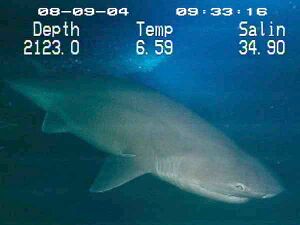القرش البقرة
| القرش البقرة Cow sharks | |
|---|---|

| |
| التصنيف العلمي | |
| أصنوفة غير معروفة (أصلحها): | الحياة |
| مملكة: | الحيوانية |
| Phylum: | حبليات |
| رتبة: | شبيهات سداسية الخياشيم |
| الفصيلة: | القرش_البقرة J. E. Gray، 1851 |
| الأجناس | |
|
طالع النص | |
Cow sharks are a shark family, the Hexanchidae, characterized by an additional pair or pairs of gill slits. Its 37 species are placed within the 10 genera: Gladioserratus, Heptranchias, Hexanchus, Notidanodon, Notorynchus, Pachyhexanchus, Paraheptranchias, Pseudonotidanus, Welcommia, and Weltonia.[2][3]
Cow sharks are considered the most primitive of all the sharks, as their skeletons resemble those of ancient extinct forms, with few modern adaptations. Their excretory and digestive systems are also unspecialized, suggesting they may resemble those of primitive shark ancestors. A possible hexanchid tooth is known from the Permian of Japan, making the family a possible extant survivor of the Permian-Triassic extinction.[4]
Their most distinctive feature, however, is the presence of a sixth, and, in two genera, a seventh, gill slit, in contrast to the five found in all other sharks.[5] They range from 1.4 to 5.5 m (4.6 to 18.0 ft) in adult body length.
Cow sharks are ovoviviparous, with the mother retaining the egg cases in her body until they hatch. They feed on relatively large fish of all kinds, including other sharks, as well as on crustaceans and carrion.[6]
The only fossil records of the cow shark consist of mainly only isolated teeth. Although skeletal remains for this species have been found from the Jurassic time period, these have been very rare and have only been found in the "Late Jurassic lithographic limestones of South Germany, Nusplingen, Solnhofen, and late Cretaceous calcareous sediments of Lebanon." Due to these sparse records some scientists conclude that the cow shark is now a more "diverse and numerous species".[7]
. . . . . . . . . . . . . . . . . . . . . . . . . . . . . . . . . . . . . . . . . . . . . . . . . . . . . . . . . . . . . . . . . . . . . . . . . . . . . . . . . . . . . . . . . . . . . . . . . . . . . . . . . . . . . . . . . . . . . . . . . . . . . . . . . . . . . . . . . . . . . . . . . . . . . . . . . . . . . . . . . . . . . . . .
الأنواع

The 37 species of cow shark, in 10 genera, are:[1]
- †Gladioserratus Underwood, Goswami, Prasad, Verma & Flynn, 2011
- †Gladioserratus aptiensis Pictet, 1864
- †Gladioserratus dentatus Guinot, Cappetta & Adnet, 2014
- †Gladioserratus magnus Underwood, Goswami, Prasad, Verma & Flynn, 2011
- Heptranchias Rafinesque, 1810
- Heptranchias perlo (Bonnaterre, 1788) (sharpnose sevengill shark)
- †Heptranchias ezoensis Applegate & Uyeno, 1968
- †Heptranchias howelli Reed, 1946
- †Heptranchias karagalensis Kozlov in Zhelezko & Kozlov, 1999
- †Heptranchias tenuidens Leriche, 1938
- Hexanchus Rafinesque, 1810
- Hexanchus griseus (Bonnaterre, 1788) (bluntnose sixgill shark)
- Hexanchus nakamurai Teng, 1962 (bigeyed sixgill shark)
- Hexanchus vitulus Daly-Engel, 2018[8][9] (atlantic sixgill shark)
- †Hexanchus agassizi Cappetta, 1976
- †Hexanchus andersoni Jordan, 1907
- †Hexanchus casieri Kozlov, 1999
- †Hexanchus collinsonae Ward, 1979
- †Hexanchus gracilis Davis, 1887
- †Hexanchus hookeri Ward, 1979
- †Hexanchus microdon Agassiz, 1843
- †Hexanchus tusbairicus Kozlov in Zhelezko & Kozlov, 1999
- †Notidanodon Cappetta, 1975
- †Notidanodon brotzeni Siverson, 1995
- †Notidanodon dentatus Woodward, 1886
- †Notidanodon lanceolatus Woodward, 1886
- †Notidanodon loozi Vincent, 1876
- †Notidanodon pectinatus Agassiz, 1843
- Notorynchus Ayres, 1855
- Notorynchus cepedianus (Péron, 1807) (broadnose sevengill shark)
- †Notorynchus borealus Jordan & Hannibal, 1923
- †Notorynchus kempi Ward, 1979
- †Notorynchus lawleyi Cigala Fulgosi, 1983
- †Notorynchus primigenius Agassiz, 1843
- †Notorynchus serratissimus Agassiz, 1843
- †Notorynchus subrecurvus Oppenheimer, 1907
- †Pachyhexanchus Cappetta, 1990
- †Pachyhexanchus pockrandti Ward & Thies, 1987
- †Paraheptranchias Pfeil, 1981
- †Paraheptranchias repens Probst, 1879
- †Pseudonotidanus Underwood & Ward, 2004
- †Pseudonotidanus semirugosus Underwood & Ward, 2004
- †Welcommia Klug & Kriwet, 2010
- †Welcommia bodeuri Cappetta, 1990
- †Welcommia cappettai Klug & Kriwet, 2010
- †Weltonia Ward, 1979
- †Weltonia ancistrodon Arambourg, 1952
- †Weltonia burnhamensis Ward, 1979
المراجع
- ^ أ ب Froese, Rainer, and Daniel Pauly, eds. (2011). "Hexanchidae" in FishBase. February 2011 version.
- ^ Allen, 45
- ^ Compagno, L., Dando, M. and Fowler, S. Sharks of the World. Princeton Field Guides ISBN 0-691-12072-2
- ^ Burrow, Carole J.; Hovestadt, D. C.; Turner, Sue. "New information on the Devonian shark Mcmurdodus, based on material from western Queensland, Australia". www.academia.edu. Retrieved 2016-06-03.
- ^ Matt's, J. & Last P.R. (1998). Paxton, J.R. & Eschmeyer, W.N. (eds.). Encyclopedia of Fishes. San Diego: Academic Press. p. 61. ISBN 0-12-547665-5.
- ^ Allen, Thomas B. The Shark Almanac. New York: The Lyons Press, 1999. ISBN 1-55821-582-4
- ^ Klug, Stefanie and Kruiwet, Jurgen, “A new Jurassic cow shark (Chondrichthyes, Hexanchiformes) with comments on Jurassic hexanchiform systematics” Swiss Journal of Geosciences, 12 November 2011. https://www.researchgate.net/publication/234060567
- ^ "New shark species confirmed: Genetic testing finds a different sixgill shark".
- ^ "New species of shark discovered through genetic testing".


